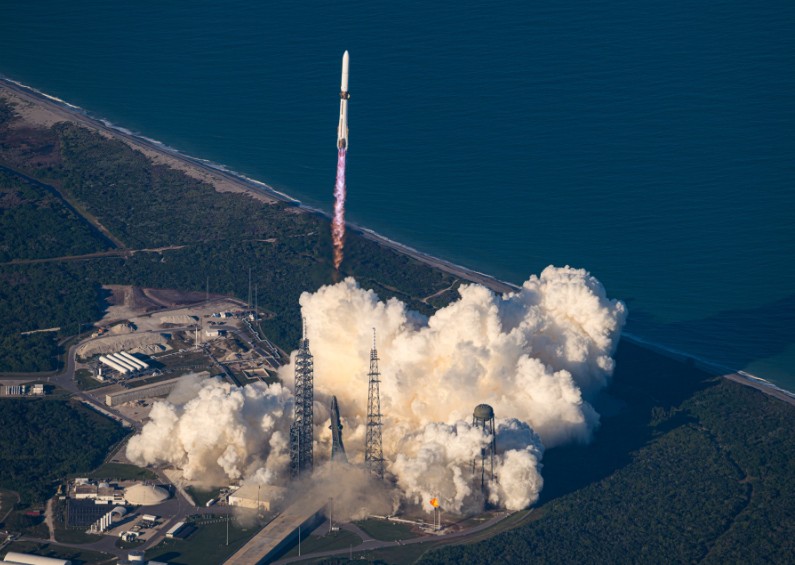Blue Origin has taken a major leap forward in the global space race after its New Glenn rocket successfully lifted off from Cape Canaveral Space Force Station on Thursday, autumn.
The launch, which had been pushed back by four days due to stormy rainfall and heightened solar activity, marked only the rocket’s alternate flight, yet it still managed to deliver a brace of NASA Mars orbiters into deep space.
The moment the 321- bottom-altitudinous launch vehicle thundered into the sky, it gestured further than just another rocket launch. For Blue Origin, it was a pivotal test of trustworthiness, reusability and its intentions to contend head-on with long-time rival SpaceX.
A Cheer-Filled Booster Landing
In a highlight of the charge, the New Glenn’s first-stage supporter made a clean, upright wharf on a drone boat deposited roughly 375 long hauls out in the Atlantic Ocean.
The scene inside Blue Origin’s Launch Control erupted into cheers, with author Jeff Bezos watching proudly as the supporter touched down.
The success is an important milestone following a failed recovery attempt during the rocket’s debut flight back in January.
It also strengthens Blue Origin’s drive towards applicable launch systems, a move seen as vital to driving down charge costs and securing new marketable and government contracts.
NASA’s Escapade Orbiters Begin Their Long Ride to Mars
The mission’s main payload, known as Escapade, consists of two identical NASA orbiters designed to study Mars’ atmosphere and magnetic environment.
Rather than heading straight for the Red Planet, the spacecraft will first cruise to a point roughly one million long hauls from Earth, where it’ll remain for about a time.
TOUCHDOWN Blue Origin New Glenn!
New Glenn just launched and landed successfully!
First reusable heavyweight rival to SpaceX is ALIVE.
A new giant just entered orbit and it’s not from SpaceX.More competition means lower costs, faster progress, more missions.
Win for the… pic.twitter.com/OxYoOZhcAB
— Razim (@Mostlyy_Human) November 13, 2025
Coming afterlife, when Earth and Mars reach a favourable alignment, the orbiters will perform a graveness- help manoeuvre around Earth that will slingshot them on their final route to Mars. appearance is presently anticipated in 2027.
Once they slip into the Martian route, the binary satellites will examine how the Earth’s thin atmosphere and scattered glamorous fields interact with the solar wind.
Working together in stereo, they should capture data that scientists have noway been able to gather ahead.
Experimenters hope this will consolidate understanding of how Mars lost its formerly thick atmosphere, and help shape unborn plans to protect astronauts from radiation during mortal operations to the Earth.
A Low-Cost Mission with High Scientific Value
Despite its deep-space goals, Escapade is regarded as one of NASA’s more cost-efficient planetary science missions. Managed by the University of California, Berkeley, the project has been developed on a budget of under $80 million.
NASA secured a reduced launch price by opting to fly the orbiters on an early New Glenn mission, even after giving up a more direct 2024 launch window due to ongoing concerns over the rocket’s development schedule at the time.
Blue Origin’s Growing Role in Deep-Space Projects
Thursday’s launch strengthens Blue Origin’s standing as a major contender in the commercial launch market.
The company, founded in 2000, is already contracted by NASA to deliver a future Artemis lunar landing and plans to test-fly its Blue Origin lunar lander on a New Glenn rocket in the coming months.
After a successful launch on @blueorigin’s New Glenn rocket, our ESCAPADE mission has begun its journey – ultimately destined for Mars. The twin spacecraft will orbit the Red Planet, investigating how the solar wind stripped its atmosphere. https://t.co/URspHkGcLx pic.twitter.com/sMahZAN2Ov
— NASA (@NASA) November 14, 2025
The timing is significant, as NASA lately restarted competition for the first crewed Artemis launch, a move urged by worries about delays in SpaceX’s Starship programme, which had initially been named for the charge.
With New Glenn showing progress and trustability, Blue Origin is situating itself as a serious contender for the coming generation of US- led deep- space operations.
A Strong Signal for the Future
The successful Blue Origin New Glenn rocket launch not only sends NASA’s Mars orbiters on their long interplanetary journey, but also strengthens the company’s push into large-scale exploration missions.
From booster recovery to payload deployment, the mission demonstrated that Blue Origin is increasingly ready to play a central role in NASA’s future, from Mars research all the way to the Moon.






